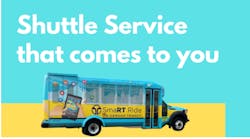SacRT to transition SmaRT Ride on-demand microtransit service to new shared-use mobility program
The Sacramento Regional Transit District (SacRT) is transitioning its SmaRT Ride on-demand microtransit service to a new shared-use mobility program. Launching Jan. 2, 2025, SacRT Flex aims to prioritize eligible riders with the greatest transportation needs such as people with disabilities, low-income individuals and seniors. The final day of SmaRT Ride service will be Dec. 31, 2024.
SacRT is hosting a public virtual workshop on Nov. 6, 2024, to discuss the transition and invite feedback. Public comments on the program will be accepted through Nov. 30, 2024.
SacRT Flex highlights:
- Corner-to-corner shared-ride service: Accessible via mobile app or phone and reservable in advance, ensuring easy access for all riders.
- Same service zones and hours: Serving the existing SmaRT Ride zones, Monday through Friday, from 7:00 a.m. to 7:00 p.m.
- Real-time updates and reliable accessibility: Each vehicle is 100 percent wheelchair-accessible, equipped with a rear-entry wheelchair lift for added convenience.
SacRT notes the SacRT Flex riders will pay a flat fare of $2.50 per trip, with free travel for companions and attendants accompanying eligible riders. Eligible riders will need to pre-register for the new service, which is expected to open in December 2024.
Why the change?
According to the agency, since its introduction as a pilot program in 2018, SmaRT Ride has provided a crucial service in the Sacramento, Calif., region but faces high operating costs. Currently, SmaRT Ride’s annual expenses exceed $8 million while funding sources, including Measure A’s Neighborhood Shuttle program, contribute only $800,000 annually. To ensure financial sustainability and to meet the requirements of SB125, SacRT has re-envisioned its on-demand service model, prioritizing essential riders needing lifeline service while lowering operating costs.



